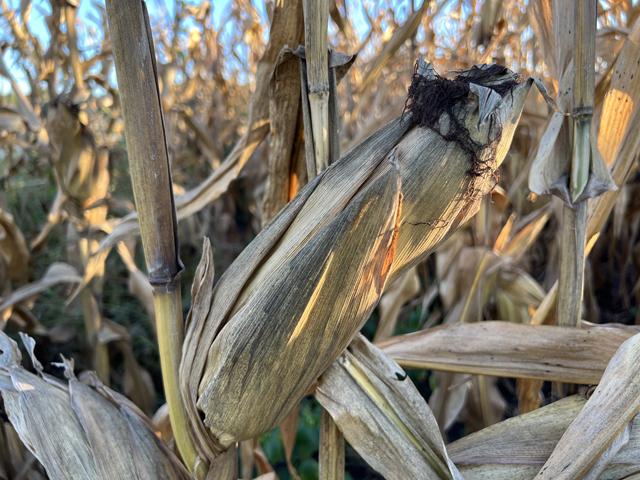Production Blog
Black Is Back in Corn Fields This Fall
If your combine took on a dark, foreboding look this fall, it wasn't just Halloween come early. The gray or black "dust" on corn plants and the cloud encompassing the combine are microscopic spores produced by fungi.
Iowa State University plant pathologist Alison Robertson posted a blog that gets down to the dirt of the matter.
"The corn is black because the tissues are being colonized by saprophytic fungi -- microorganisms that feed on dead plant material," Robertson wrote. Moisture, warm weather, humidity, and morning fog and dew all favored growth of these organisms.
Saprophytic fungi help decompose crop residue. They generally grow on the corn husks but don't typically cause damage to the ear underneath. Since they are not pathogens of corn, they will not be a source of inoculum for diseases next year, Robertson said.
P[L1] D[0x0] M[300x250] OOP[F] ADUNIT[] T[]
All residue is susceptible. Soybeans can kick up a cloud of black, too, Robertson told DTN in an email.
Low temperatures, like the frosty mornings of late, will stop the fungus growing, she added. But more rain, followed by warm weather could reinvigorate the fungus.
No management is necessary for the issue, but dust masks are encouraged for individuals with allergies or respiratory problems to reduce breathing in masses of spores. These saprophytic fungi are a big contributor to the mold portion of the pollen and mold counts.
See an Iowa State University blog and video that talks about additional resources on respiratory protection during harvest at https://crops.extension.iastate.edu/…. Keeping combine engines and filters clean is also important.
This black soot is different than tar spot, a late-season disease known to infest cornfields. Tar spot is characterized by distinct irregular-shaped raised spots that are scattered across the leaf surface -- think road tar sprinkled on the leaf. Saprophytic fungal growth looks fuzzy or out-of-focus on the corn leaf, Robertson said.
It's hard to miss the black fungus. It shows up easily on hands, white t-shirts and almost everything it touches.
Find Robertson's entire blog here: https://crops.extension.iastate.edu/….
Pamela Smith can be reached at pamela.smith@dtn.com
Follow her on X, formerly known as Twitter, @PamSmithDTN
(c) Copyright 2023 DTN, LLC. All rights reserved.





Comments
To comment, please Log In or Join our Community .